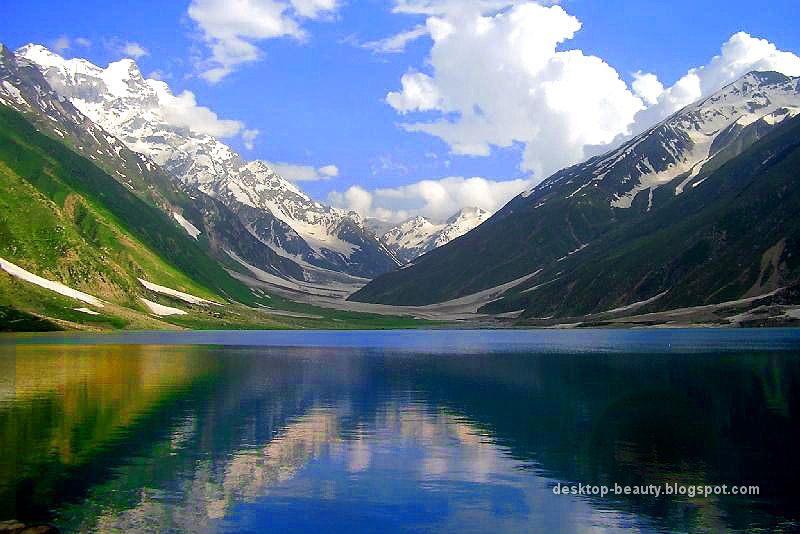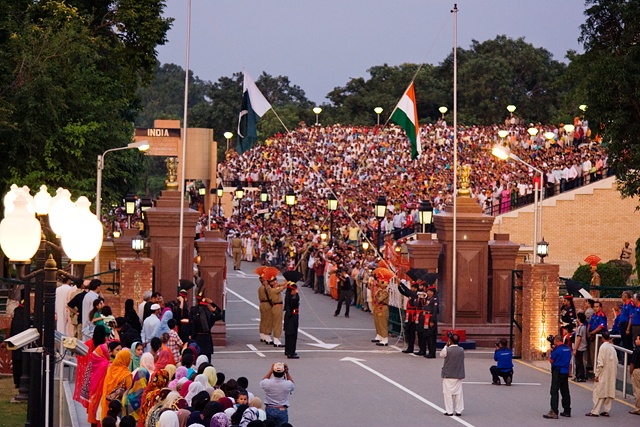
This ceremony takes place every evening before sunset at the Wagah border, which as part of the Grand Trunk Road was the only road link between these two countries before the opening of the Aman Setu in Kashmir in 1999. The ceremony starts with a blustering parade by the soldiers from both the sides, and ends up in the perfectly coordinated lowering of the two nations’ flags.[2] It is called the beating retreat border ceremony on the international level. One Jawan (infantryman) stands at attention on each side of the gate. As the sun sets, the iron gates at the border are opened and the two flags are lowered simultaneously. The flags are folded and the ceremony ends with a retreat that involves a brusque handshake between soldiers from either side, followed by the closing of the gates again. The spectacle of the ceremony attracts many visitors from both sides of the border, as well as international tourists
The Badshahi Mosque in Persian Padshahi Masjed means the ‘Imperial Mosque’ in Lahore, commissioned by the sixth Mughal Emperor Aurangzeb in 1671 and completed in 1673, is the second largest mosque in Pakistan and South Asia and the fifth largest mosque in the world. Epitomising the beauty, passion and grandeur of the Mughal era, it is Lahore’s most famous landmark and a major tourist attraction.[1] It is located in Iqbal Park in Lahore, Pakistan which is one of the largest urban parks in Pakistan. Capable of accommodating 55,000 worshippers in its main prayer hall and a further 95,000 in its courtyard and porticoes
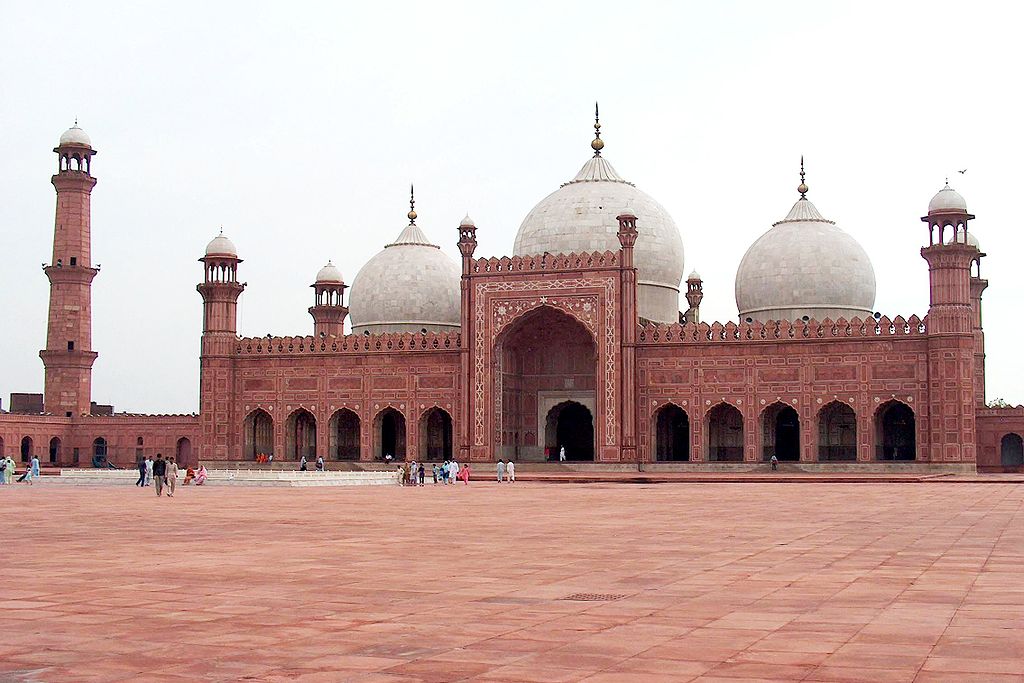
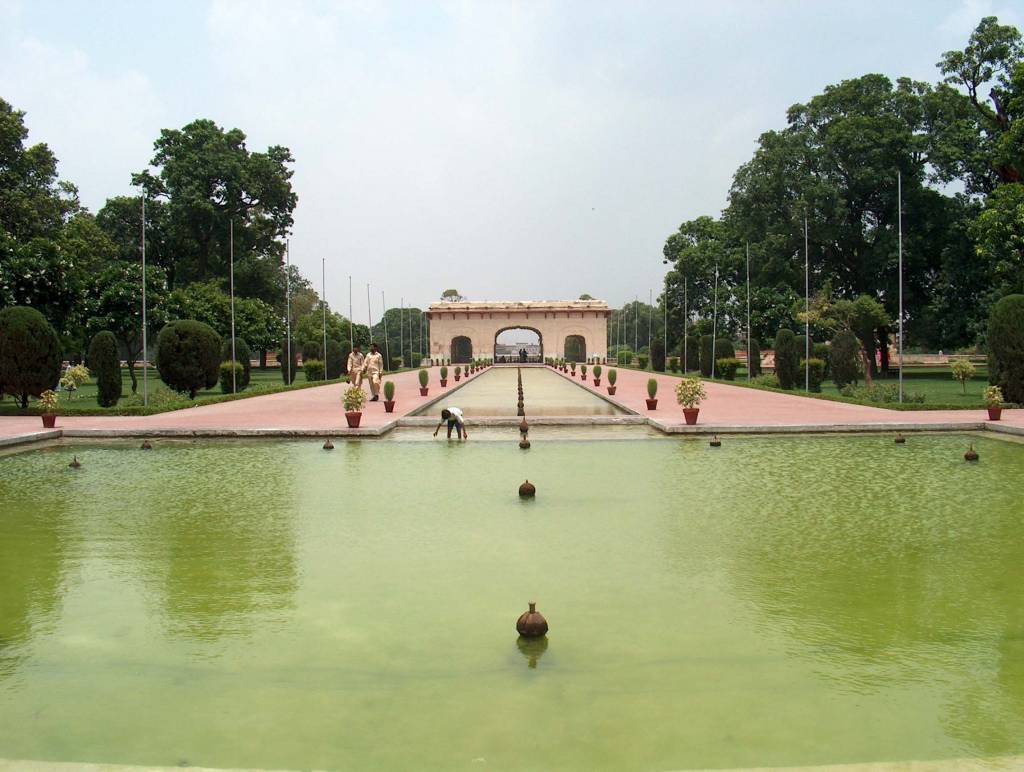
The Shalimar Gardens are located near Baghbanpura along the Grand Trunk Road some 5 kilometers northeast of the main Lahore city. Shalimar Gardens draws inspiration from Central Asia, Kashmir, Punjab, Persia, and the Delhi Sultanate.
The Lahore Museum (Punjabi: لاہور میوزیم, Urdu: لاہور عجائب گھر), was originally established in 1865-66 on the site of the hall or building of the 1864 Punjab Exhibition The Museum contains some fine specimens of Mughal and Sikh door-ways and wood-work and has a large collection of paintings dating back to the Mughal, Sikh and British periods. It includes a collection of musical instruments, ancient jewellery, textiles, pottery, and armory. There are important relics from the Indus Valley civilisation, Ghandara and Graeco-Bactrian periods as well as some Tibetan and Nepalese work on display. The museum has a number of Greco-Buddhist sculptures, Mughal and Pahari paintings on display.The Fasting Buddha from the Ghandara period is one of the most famous objects of the museum. The ceiling of the entrance hall features a large mural by renowned Pakistani artist Sadequain.
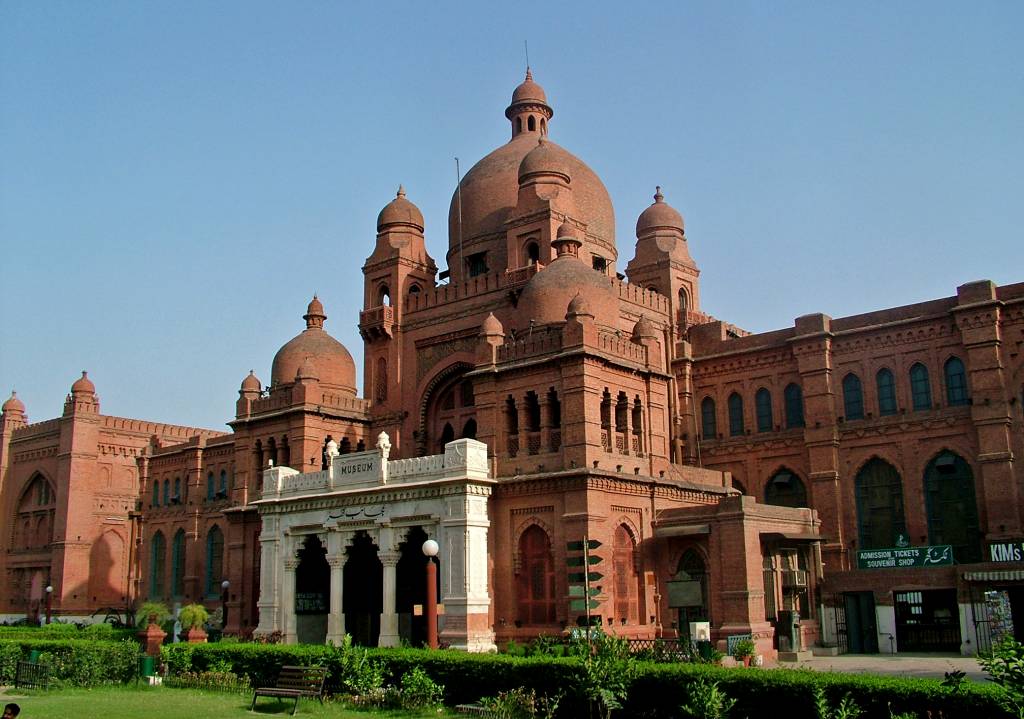
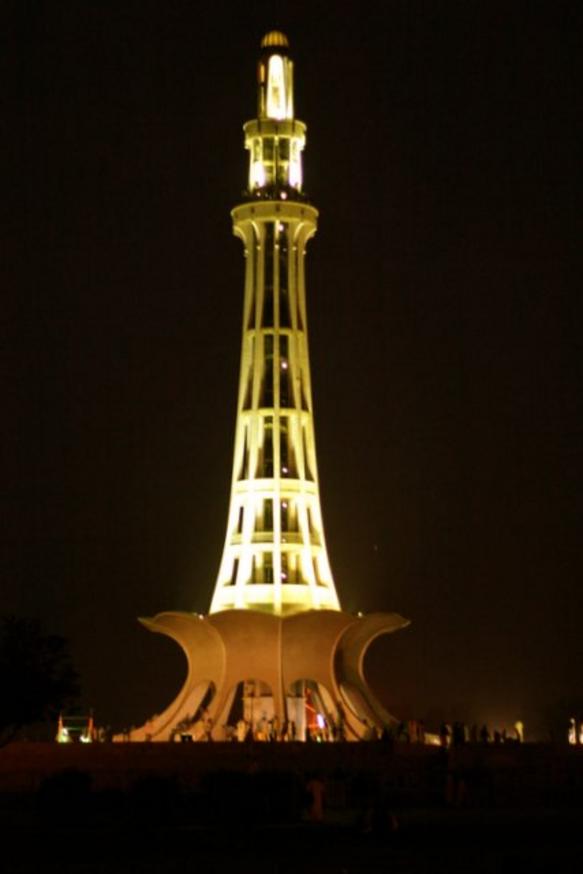
Minar-e-Pakistan, literally “Tower of Pakistan” is a public monument located in Iqbal Park which is one of the largest urban parks in Lahore, Pakistan. The tower was constructed during the 1960s on the site where, on 23 March 1940, the All-India Muslim League passed the Lahore Resolution, the first official call for a separate homeland for the Muslims living in the South Asia, in accordance with the two nation theory. The foundation stone was laid on 23 March 1960. The construction took eight years, and was completed in 1968. The Minar was completed on 31 October 1968 at an estimated cost of Rs. 705,8000. Today, the minaret provides a panoramic view to visitors who can climb up the stairs or through an elevator. The parks around the monument include marble fountains and an artificial lake
Naran is a medium sized town in upper Kaghan Valley in Mansehra District of Khyber Pakhtunkhwa province of the Pakistan. It is located 119 kilometers (74 mi) from Mansehra city at the altitude of 8,202 feet (2,500 m). Naran is one of the most scenic town in Pakistan, attracting thousands of tourists, trekkers, photographers and nature-enthusiast, every year. The Kunhar River, swollen by glacier melt, passes through this town as it meanders its way through the valley.[1] Kunhar river in Naran during the month of June as viewed from PTDC motel Naran can be considered as base station to scenic destinations like Lake Saif-ul-Malook, Lalazar Babusar, Noori Valley and Purbi Valley.
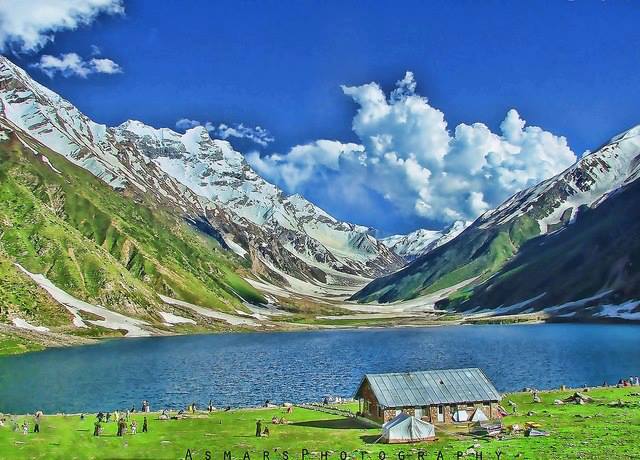

The Murree Galliat region is known for its scenic vistas of pine- and oak-covered mountains, criss-crossed with springs and rivulets and dotted with lawns and orchards. On clear days a good view of the snowy peaks of Kashmir is possible, and the crest of Nanga Parbat can sometimes be seen. Tourist attractions in the area include the Murree Wildlife Park.Whereas Arjun Bhandari, a senior journalist of Nepal, says the place looks like Nagarkot, a tourist destination of Bhaktapur, Nepal. Patriata (also called New Murree), is one of the pivotal attractions of Murree. This place, which is 15 km away from Murree Hills, is famous for its chairlift that gives a bird-eye view of the Kashmir green hills. It is at the highest point of Murree Hills that subsequently makes it the highest point of Punjab as well. [7]Ayubia is also a center of attraction in Murree, which comprises four hill stations including Khanspur, Ghor Daka, Changla Gali, Khairagali. Ayubia Chairlift and shops offering cultural shawls, caps and necklaces are the major appeal of this place. Scenic Nathiagali, situated in Abbottabad at a distance of 2500m from Murree, is popular for its maple, pine, walnut and oak trees. Mall road in Murree is the center of major economic activities. The entire road is full of shops selling a multitude of things for the tourists. Major Banks, hotels and restaurants are situated at Mall Road
The Lahore Fort, locally referred to as Shahi Qila is citadel of the city of Lahore, Punjab, Pakistan. It is located in the northwestern corner of the Walled City of Lahore. The trapezoidal composition is spread over 20 hectares.Origins of the fort go as far back as antiquity, however, the existing base structure was built during the reign of Mughal Emperor Akbar between 1556–1605 and was regularly upgraded by subsequent Mughal, Sikh and British rulers.It has two gates one is known as Alamgiri Gate build by Emperor Aurangzeb which opens towards Badshahi Mosque and other older one known as Masti or Masjidi Gate which open towards Masti GateArea of Walled City and was built by Emperor Akbar. Currently Alamgiri Gate is used as the principal entrance while Masti Gate is permanently closed .The fort manifests the rich traditions of Mughal architecture. Some of the famous sites inside the fort include: Sheesh Mahal, Alamgiri Gate, Naulakha pavilion, and Moti Masjid. In 1981, the fort was inscribed as a UNESCO World Heritage Site along with the Shalimar Gardens (Lahore).
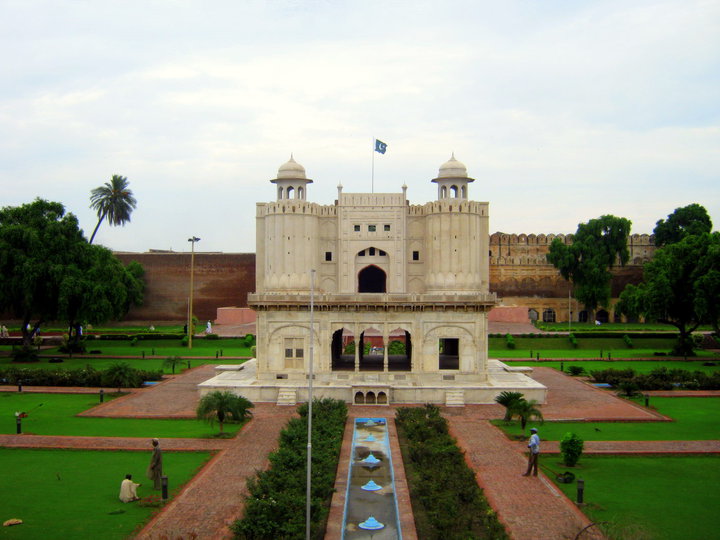
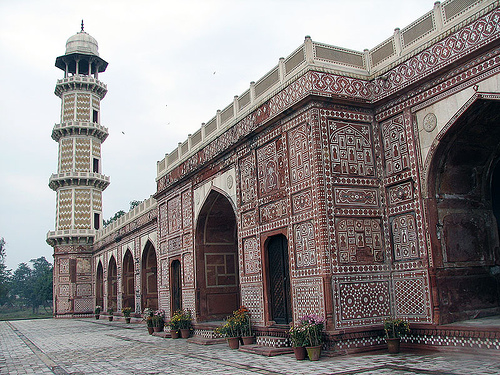
Jahangir died at Rajauri in 1627 in Lahore. His tomb was built and completed by Emperor Shah Jahan in 1637 AD, at the cost of ten Lakhs Rupees. The entrance to the mausoleum is through two massive gateways of stone and masonry opposite each other (to the north and south) which lead to a square enclosure known as the Akbari Serai. This enclosure leads to another one, on the Western side, giving full view of the garden in front of the mausoleum, which is traversed by four bricked canals proceeding from the center, and in which many fountains were placed which are now ruined. The corridor around the mausoleum is adorned with a very elegant mosaic, representing flowers and verses from the Quran
Saiful Muluk (Urdu: جھیل سیف الملوک)is a mountainous lake located at the northern end of the Kaghan Valley near the town of Naran, It is in the north east of Mansehra District in the Khyber-Pakhtunkhwa province, Pakistan. At an altitude of 3,224 m (10,578 feet) above sea level it is amongst one of the highest lakes in Pakistan.There is also a similar named fictional story associated with the lake. The weather here is moderate during day time while the temperature drops to minus degrees at night. Saiful Muluk is located in district larkana of Hazara Division. It is about eight kilometers north of Naran, in the Northern part of Kaghan valley. Malika Parbat, the highest peak in the valley is located near tSaiful Muluk was formed by glacial moraines that blocked the water of the stream passing through the valley.Water from multiple glaciers around the lake feed the lake A fairy tale called Saiful Muluk, written by the famous Sufi poet Mian Muhammad Bakhsh, is associated with the lake.It is the story of the prince of Persia who fell in love with a fairy princess at the lake named.The impact of the lake’s beauty is of such extent that people believe that fairies come down to the lake in the full moon.
